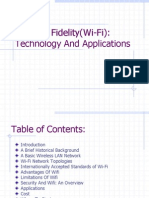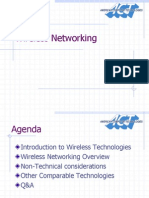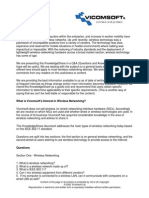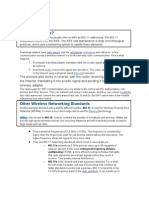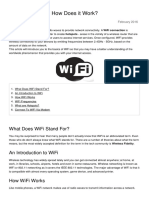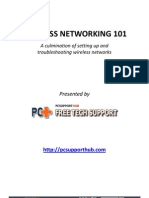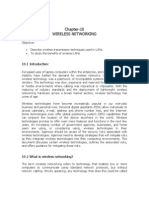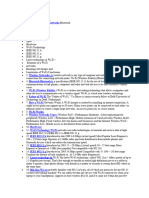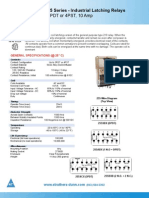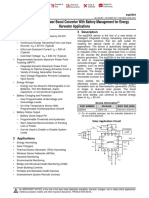Wifi Interview Questions
Wifi Interview Questions
Uploaded by
ronyiutCopyright:
Available Formats
Wifi Interview Questions
Wifi Interview Questions
Uploaded by
ronyiutOriginal Description:
Copyright
Available Formats
Share this document
Did you find this document useful?
Is this content inappropriate?
Copyright:
Available Formats
Wifi Interview Questions
Wifi Interview Questions
Uploaded by
ronyiutCopyright:
Available Formats
JOB EXCLUSIVE Collected by: Rony Parvej
Wi-Fi
1. What is Piggybacking in context to Wi-Fi? Piggybacking is a term which states that something that is riding on the back of something else to complete his/her motive, just like similar to an idiom putting gun to anothers shoulder and performing the Hunting, so piggybacking is a term used to refer to access of a wireless internet connection by bringing ones own computer within the range of anothers wireless connection, and using that service without the subscribers explicit permission or knowledge. It is a legally and ethically controversial practice, with laws that vary in jurisdictions around the world. Piggybacking is an unauthorized tapping into anothers connection with a public utility. For e.g.- So piggybacking can be takes place like when I am accessing the wireless connection of my neighbor Wi-Fi without his/her knowledge by hacking his static ip address, then it would be possible for me to access the Wi-Fi connection of others. 2. What are the recommended channels if you are setting up three WLANs and want minimum interference over there? There is a need of selecting the channels for setting up WLANs, to communicate; all the components of a Wi-Fi network must use the same channel. In the Wi-Fi network in infrastructure mode (using an access point), it depends on the channel set at the access point. For better results when using Wi-Fi, it is necessary to adjust the channel on the access point as well as configured on the client, to take the least use channel in your neighborhood. To do this you can use software such as NetStumbler, which will list the neighborhood Wi-Fi networks and channels used. Note:- The channels most frequently used to select one as free as possible. So the recommended channels are as follows:Channel 1: 2.412 MHz Channel 2: 2.417 MHz Channel 3: 2.422 MHz Channel 4: 2.427 MHz Channel 5: 2.432 MHz
Channel 6: 2.437 MHz You can choose from these channels while setting up the WLANs. 3. How to crack Wi-Fi network, if you are using WEP (Wired Equivalent Privacy) Password with backtrack? The first line of defense of your Wi-Fi network is encryption, which encodes the data transmitted between your PC and your wireless router. WEP abbreviates for (Wireless Encryption Protocol) it is a less-secure protocol than WPA (Wireless Protected Access). Since WEP is relatively easy to crack, so you have to use the same form on all devices on your network. If you have an older router that supports WEP only youll be best safest if you use 128-bit bit WEP keys but also check the manufacturers Web site for a firmware update that will add WPA support. Two of the most popular programs used for actually cracking the WEP key are Airsnort and Aircrack. Airsnort can be used with the .dump files that Kismet provides; and Aircrack can be use with .cap files that Airodump provides. 4. Differentiate between Ad-Hoc and Infrastructure topology and also explain with their advantages and disadvantages? Wireless networks typically work in one of two configurations: Ad-Hoc or Infrastructure. Ad-Hoc is Latin meaning for this purpose so these are the networks which are basically created for some purpose. So these are the group of workstations which communicate directly witch each other to exchange information. An Ad-Hoc network is also called as a peer to peer network. Here are some benefits of an Ad-Hoc network are:a) The possibilities with Ad-Hoc network are quite endless. b) Ad-Hoc networks are simple to set up. c) Ad-Hoc networks are inexpensive. d) Ad-Hoc networks are fast. Disadvantages of an Ad-Hoc network are as follows:a) It is not able to get into the mainstream wired local area network. b) It needs more technology to support their reliability. c) As the network increases its speed slows down considerably.
In Infrastructure mode, network includes an access point when the wireless clients connect to an access point, which in turn bridges to a network. Infrastructure network can pass information through a central information hub which can be both, hardware or software device on a computer. So under this devices in a wireless network are set up to communicate through an access point. An infrastructure network enables you to:a) In this you do not have to control over the path your data takes. b) Connect to a wired network. c) Extend your wireless networks range. d) Utilize roaming ability. Disadvantages for Infrastructure network are:1. Use of more wireless access points. 2. This increase the cost of implementing a wireless network solution. 5. How do you secure a wireless network? Key points for securing a wireless network are as follows:a) Verify that your PCs software firewall is turned on, and that Windows file-sharing feature is off; its off by default in Windows XP with Service Pack 2. b) Never send bank passwords, credit card numbers, confidential e-mail, or other sensitive data unless youre sure youre on secure site: Look for the lock icon in the bottom-right corner of your browser, as well as a URL in the address bar that begins with https. Such sites build in their own encryption. c) Always turn your Wi-Fi radio off when you're not at a hotspot: Hackers can use it to create peer-to-peer Wi-Fi connections with your computer and access it directly. d) For better security, consider signing up for a paid subscription to a hotspot network such as Boingo or T-Mobile. Both companies provide connection software that encrypts your sessions automatically. By attaining these key points you can secure wireless network up to an extent. 6. What are your preferred tools for WarDriving? Preferred tools for WarDriving are as follows:a) Kismet- Kismet is a 802.11b wireless network sniffer. It is capable of sniffing using almost
any wireless card supported in Linux. b) Airsnort- is one of the first tools to come out discovering insecurity of wireless network. AirSnort is a wireless LAN (WLAN) tool which cracks encryption keys on 802.11b WEP networks. AirSnort operates by passively monitoring transmissions, computing the encryption key when enough packets have been gathered. c) WEPCrack is Perl based tool. WEPCrack is a tool that cracks 802.11 WEP encryption keys using the latest discovered weakness of RC4 key scheduling. d) WaveStumbler is console based 802.11 network mapper for Linux. It reports the basic AP stuff like channel, WEP, ESSID, MAC etc. e) Aircrack yet another WEP cracking tool for Linux courtesy by divine. 7. How can you configure Wi-Fi network and what are Wi-Fi Protocols? Basically there are many standards of Wi-Fi in the industry but some popular of them are 802.11a, 802.11b, 802.11g/n. With the support of these Wi-Fi protocols we can communicate/interact among the devices at the speed of 5Ghz to 2.4Ghz dual band communication. If we have Wi-Fi nic card so firstly we have to install their drivers and after installation if we have Wi-Fi access point then we can see the signal strength in the right corner below just open that and find the access point to connect, if access point is configured with the security, type the key to connect and enjoy the service. Wi-Fi is technically referred to as the 802.11 protocol. Over time, Wi-Fi has improved, giving rise to different variations of the protocol. 802.11a This version operates at 54Mbps. It is considered as the favorite wireless LAN protocol for IP telephony. 8. How is UWB (ultra-wideband) different from Bluetooth, FireWire and Wi-Fi? UWB is Radio Frequency technology that transmits binary data, using low energy and short duration impulses over a wide spectrum of frequencies. It delivers data over 15 to 100 meters and does not require a dedicated radio frequency. For example, a UWB signal centered at 5GHz typically extends across 4GHz and 6GHz. At longer distances, UWB data rates drop considerably. Bluetooth:- The key difference among UWB and Bluetooth are of range, power, consumption and intended use. It is basically meant for short distances up to (10m). It is low power consuming than UWB. Since FireWire is meant to deliver high speed, it is also designed to work with high power drain
services. It therefore can provide much more power to the devices that connect to it. It can deliver up to 60 watts of energy. So the only difference here is of power it uses more power than UWB. Wi-Fi really wasnt built to move audio and video, it was built for data traffic where if theres delay, while UWB is better suited for multimedia for a couple of reasons, i.e. for starters, its throughput for surpasses that of Wi-Fi. 9. Who are the providers and what are the assets available for wireless? Some of the providers for wireless are as follows:a) Wireless Internet- Nationwide Coverage Unlimited b) Faster Internet on Mobile c) New 3G BlackBerry d) Aircel Pocket Internet e) Reliance 3G Online Offer f) Cisco Managed Switches Brand assets are available here for wireless, brand assets can also be applied to m-branding. In particular, three of the assets can be targeted directly for improvement with the m-branding methods that are available today. These are brand awareness, brand associations and brand loyalty. 10. Wireless networking, or Wi-Fi, can be used to connect computers in a home, and many cities are using technologies to offer free or low cost internet access to residents, what is another name for Wi-Fi? IEEE 802.11 is the official name for WIFI wireless specification. It is composed of more than 20 different standards (802.11a, 802.11b, etc), each of which have their own defining characteristics. Since not all standards operate on the same frequency, not all 802.11 devices are compliant with one another, so be sure to consider the compatibility when making your purchasing decision. So this is an alternative name for Wi-Fi which suits all the properties of the Wi-Fi and functioning as well. Wireless networking hardware requires the use of underlying technology that deals with radio frequencies as well as data transmission. The most widely used standard is 802.11 produced by the Institute of Electrical and Electronic Engineers (IEEE). This is a standard defining all aspects of Radio Frequency Wireless networking. 11. Can I mix wireless equipments from different vendors, elaborate on it?
You can mix wireless equipments from different vendors, but the recommendation is that you should prefer only prescribed vendors, because most wireless networking hardware vendors support the 802.11 standard they can inter operate. However, we recommend verification as the standard is a fairly recent one, and does specify two different methods for wireless communications; Frequency Hopping (FH) and Direct Sequence Spread Spectrum (DSSS or DS), which are not interoperable. When purchasing wireless networking hardware from separate vendors be sure to obtain guarantees from the vendors that the hardware will interoperate and follows the standards. Within a short time we expect all new wireless cards, like ethernet cards, to become inexpensive, ubiquitous and totally interoperable. Also of note is that the latest version of the standard defines 11mbps and 5.5mbps networking, with support for the older standard 1mbps and 2mbps speeds. This provides some compatibility with different or older equipment. Note that this new standard covers DS-type Networks, not FH types. Software access points such as InterGate which uses the wireless interface of the host computer should have no compatibility issues with third party wireless hardware, as long as standards are followed. Typically wireless hardware is identified to the software as a network interface, and therefore can be used in the same way as any other network card. So you can choose them from different vendors but keeping these things in mind and then go ahead. 12. If my computer is connected to wireless LAN, can it communicate with computer on wired LAN as well? To do this you will need some sort of bridge between the wireless and wired network. This can be accomplished either with a hardware access point or a software access point. Hardware access points are available with various types of network interfaces, such as Ethernet or Token Ring, but typically require extra hardware to be purchased if your networking requirements change. If networking requirements go beyond just interconnecting a wired network network to a small wireless network, a software access point may be the best solution. A software access point does not limit the type or number of network interfaces you use. It may also allow considerable flexibility in providing access to different network types, such as different types of Ethernet, Wireless and Token Ring networks. Such connections are only limited by the number of slots or interfaces in the computer used for this task. Further to this the software access point may include significant additional features such as shared Internet access, web caching or content filtering, providing significant benefits to users and administrators. 13. Is it true that Wireless networking is only good for laptop computer?
Although wireless networking offers obvious benefits to users of laptops who move from location to location throughout the day, there are benefits for users of fixed position computers as well: So this is not such that wireless networking is only good for laptop computers but on preference basis it got more than fixed positions, as laptop computers are portable, flexible, ease to use and move. Many schools and businesses have unsuitable building layouts or walls that cannot be wired for various reasons making it difficult or impossible to build a wired network. Wireless networking in these environments is a very cost effective alternative also providing future flexibility. In cases where a small number of computers are separated from a main network a wireless link may be more cost effective than network cabling although the latter is perfectly feasible. Temporary wireless LANs can easily be created for exhibitions, school or business projects, all without any trailing cabling. 14. What is Wi-Fi technology and over which frequency band it operates? Wi-Fi technology is a technology used for transmitting a signal using the 802.11 specifications works a lot like it does with a basic Ethernet hub: Theyre both two-way forms of communication, and they both use the same frequency to both transmit and receive, often referred to a half-duplex. WLANs used radio frequencies (RFs) that are radiated into the air from an antenna that creates radio waves. These waves can be absorbed, refracted, or reflected by walls, water, and metal surfaces, resulting in low signal strength. So because of this vulnerability to surrounding environmental factors, its pretty apparent that wire-less will never offer us the same robustness as a wired network can, but that still doesnt mean were not going to use or run the wireless or Wi-Fi. 15. What are the different Wi-Fi generations and also explain any one? The IEEE 802.11 generation is actually only the earliest standard, allowing 1-2 Mbps of bandwidth. Amendments have be made to the original standard in order to optimize bandwidth (these include the 802.11a, 802.11b and 802.11g standards, which are also called 802.11 physical standards) or to better specify components in order to ensure improved security or compatibility. Name of Generation- 802.11a Name- WiFi5 Description- The 802.11a standard (called Wi-Fi 5) allows higher bandwidth (54 Mbps maximum throughput, 30 Mbps in practice). The 802.11a standard provides 8 radio channels in the 5 GHz frequency band.
You might also like
- Moskito Ti: Lightweight Multi-Purpose Target LocatorDocument6 pagesMoskito Ti: Lightweight Multi-Purpose Target LocatorKyle YangNo ratings yet
- BLDC COMPRESSOR TCC DA HORIZONTAL r1.0Document18 pagesBLDC COMPRESSOR TCC DA HORIZONTAL r1.0Bruno Souza100% (2)
- Wi-Fi Interview Questions & AnswersDocument6 pagesWi-Fi Interview Questions & AnswersnagarajNo ratings yet
- Airport: What Is Wifi?Document4 pagesAirport: What Is Wifi?lipi_chhayaNo ratings yet
- Wifi As A ProcessDocument9 pagesWifi As A Processmishely09No ratings yet
- Fahad Kheratkar - Rhishikesh Dyade: A Presentation On Wireless Based Network and SolutionsDocument24 pagesFahad Kheratkar - Rhishikesh Dyade: A Presentation On Wireless Based Network and SolutionsFahad Impresionante KheratkarNo ratings yet
- Wireless TechnologiesDocument45 pagesWireless TechnologiesKenneth O'BrienNo ratings yet
- Introduction To How WiFi WorksDocument4 pagesIntroduction To How WiFi WorksDeepak SinhaNo ratings yet
- WirelessDocument30 pagesWirelessapi-3735095No ratings yet
- Wireless Networking: Jeffrey D. Bombell, American Computer TechnologiesDocument30 pagesWireless Networking: Jeffrey D. Bombell, American Computer Technologiesrajeshmishra1No ratings yet
- Wireless Fidelity: Technology and ApplicationsDocument22 pagesWireless Fidelity: Technology and ApplicationsPurboday GhoshNo ratings yet
- 2914 Wifi Technology2Document23 pages2914 Wifi Technology2jay shree ramNo ratings yet
- Computer Networking Image Gallery: Inside This ArticleDocument6 pagesComputer Networking Image Gallery: Inside This ArticleYogesh GiriNo ratings yet
- Wireless Fidelity: Technology and ApplicationsDocument22 pagesWireless Fidelity: Technology and ApplicationsPurboday GhoshNo ratings yet
- Wireless Networking: L.Karunakar Anusha Computer TechnologiesDocument30 pagesWireless Networking: L.Karunakar Anusha Computer TechnologiesLingala KarunakarNo ratings yet
- Wireless 5Document30 pagesWireless 5ebinVettuchirayilNo ratings yet
- How WiFi WorksDocument6 pagesHow WiFi WorkskartikNo ratings yet
- What Is WiFiDocument14 pagesWhat Is WiFipappu507No ratings yet
- What Is Wifi?: Airport Home Cities InternetDocument5 pagesWhat Is Wifi?: Airport Home Cities InternetPartha Sarathi PanigrahiNo ratings yet
- Wireless QaDocument15 pagesWireless QaAnderson JeantyNo ratings yet
- Mn603 Assignment 2Document8 pagesMn603 Assignment 2HansNo ratings yet
- Wifi Technology: by Nikhila Ann Varghese Malla Reddy Engineering CollegeDocument29 pagesWifi Technology: by Nikhila Ann Varghese Malla Reddy Engineering CollegeNeeha KuttyNo ratings yet
- Wi-Fi: Wi-Fi For "Wireless Fidelity", Is A Set of Standards ForDocument18 pagesWi-Fi: Wi-Fi For "Wireless Fidelity", Is A Set of Standards Forvivek_juyal2007No ratings yet
- Introduction To Zigbee TechnologyDocument24 pagesIntroduction To Zigbee Technologyveere_arunNo ratings yet
- Connecting People 1.abstract:: Wi-Fi TechnologyDocument9 pagesConnecting People 1.abstract:: Wi-Fi TechnologySanthosh SalemNo ratings yet
- ZigBee ReportDocument22 pagesZigBee ReportMegha BhatiaNo ratings yet
- Deepika WifiDocument9 pagesDeepika WifiAnubhuti JalanNo ratings yet
- Wifi SeminarDocument10 pagesWifi SeminarAmandeep AmanNo ratings yet
- UntitleddocumentDocument5 pagesUntitleddocumentArpit TiwariNo ratings yet
- Wifi A-31Document40 pagesWifi A-31Amrit SianNo ratings yet
- Cyber Security Module 1 Lesson 3 NotesDocument20 pagesCyber Security Module 1 Lesson 3 NotesAnshpreet SinghNo ratings yet
- The Name Wi-FiDocument5 pagesThe Name Wi-FineemaniguptaNo ratings yet
- What Is Wifi and How Does It Work 298 O1yu7tDocument2 pagesWhat Is Wifi and How Does It Work 298 O1yu7tAntoneyGeorgeNo ratings yet
- Wireless Networking 101Document9 pagesWireless Networking 101Gus MilesNo ratings yet
- What Is Fixed Wireless Access Ebook v4Document22 pagesWhat Is Fixed Wireless Access Ebook v4Irina SilesNo ratings yet
- Shawon WifiDocument10 pagesShawon WifiFoez LeonNo ratings yet
- Wi-Fi: The BasicsDocument4 pagesWi-Fi: The BasicsAjay SanchetiNo ratings yet
- Network Communication ProtocolDocument12 pagesNetwork Communication ProtocolKohinoor BegumNo ratings yet
- Unit VIIDocument6 pagesUnit VIIlarioquenerlisaNo ratings yet
- Chapter-10 Wireless NetworkingDocument7 pagesChapter-10 Wireless NetworkingVineet KohliNo ratings yet
- Wireless NetworkingDocument17 pagesWireless NetworkingIRFANNo ratings yet
- XXXX YyyDocument9 pagesXXXX YyyPrajwal GhalezNo ratings yet
- What Is Wireless Networking?Document5 pagesWhat Is Wireless Networking?Endless BachlessNo ratings yet
- Research Inventy: International Journal of Engineering and ScienceDocument5 pagesResearch Inventy: International Journal of Engineering and ScienceinventyNo ratings yet
- Wi FiDocument6 pagesWi FiAtul PalNo ratings yet
- 10 Deadly Sins in Wireless Security PDFDocument6 pages10 Deadly Sins in Wireless Security PDFbad3106No ratings yet
- Paper Presentation On "World of Wi-Fi": S.Pavan Kumar Eee Ii Year 03C91A0223Document6 pagesPaper Presentation On "World of Wi-Fi": S.Pavan Kumar Eee Ii Year 03C91A0223Vivek MurtyNo ratings yet
- Seminar On Wifi Technology..: Preeti - KulkarniDocument18 pagesSeminar On Wifi Technology..: Preeti - Kulkarnip4227No ratings yet
- Wireless NetworksDocument17 pagesWireless NetworksMian Muzammil AhmedNo ratings yet
- WIFIDocument8 pagesWIFIswathiNo ratings yet
- The Tutorials Below Will Cover Setting Up and Securing A Wireless Network For The Home and A BusinessDocument6 pagesThe Tutorials Below Will Cover Setting Up and Securing A Wireless Network For The Home and A Businesseesa4everNo ratings yet
- Wifi Notes PDFDocument0 pagesWifi Notes PDFnataline_dedonaNo ratings yet
- Introducing Wireless NetworksDocument5 pagesIntroducing Wireless NetworksAlexsandre MichelsNo ratings yet
- ch5 PDFDocument29 pagesch5 PDFilyasNo ratings yet
- Module 2 - LO3 - Set RouterDocument32 pagesModule 2 - LO3 - Set RouterLeu NameNo ratings yet
- REMOTE ACCESS VPN- SSL VPN: A deep dive into SSL VPN from basicFrom EverandREMOTE ACCESS VPN- SSL VPN: A deep dive into SSL VPN from basicRating: 5 out of 5 stars5/5 (1)
- Understanding WiFi Technology: A Comprehensive Guide (Second Edition)From EverandUnderstanding WiFi Technology: A Comprehensive Guide (Second Edition)No ratings yet
- CompTIA Network+ (N10-009) Study Guide: Comprehensive Exam Preparation and Key Concepts for Network ProfessionalsFrom EverandCompTIA Network+ (N10-009) Study Guide: Comprehensive Exam Preparation and Key Concepts for Network ProfessionalsNo ratings yet
- Early Life and Education: Anisuzzaman (18 February 1937Document3 pagesEarly Life and Education: Anisuzzaman (18 February 1937ronyiutNo ratings yet
- Road Transport Bangladesh PDFDocument4 pagesRoad Transport Bangladesh PDFronyiutNo ratings yet
- Training Evaluation Form - Energy SectorDocument5 pagesTraining Evaluation Form - Energy SectorronyiutNo ratings yet
- Eee 304 B1 A PDFDocument1 pageEee 304 B1 A PDFronyiutNo ratings yet
- Problem:: This Machine Has No Iron Loss Resistance, So The Equivalent Circuit Is As FollowsDocument4 pagesProblem:: This Machine Has No Iron Loss Resistance, So The Equivalent Circuit Is As FollowsronyiutNo ratings yet
- Solution of CT (SET-A) of MRET by Rony ParvejDocument2 pagesSolution of CT (SET-A) of MRET by Rony ParvejronyiutNo ratings yet
- EEE 259 - ct4 PDFDocument1 pageEEE 259 - ct4 PDFronyiutNo ratings yet
- FuelCells-Basics 2Document16 pagesFuelCells-Basics 2ronyiutNo ratings yet
- 38th BCS Advertisement PDFDocument19 pages38th BCS Advertisement PDFMd Nurul Islam SikdarNo ratings yet
- Viva Question SolutionDocument18 pagesViva Question Solutionronyiut100% (1)
- MCQ On BJTDocument1 pageMCQ On BJTronyiutNo ratings yet
- AE Interview Notice & List of Selected ApplicantsDocument4 pagesAE Interview Notice & List of Selected ApplicantsronyiutNo ratings yet
- Basic Course Material Winter 2015Document19 pagesBasic Course Material Winter 2015ronyiut100% (1)
- Web 2Document17 pagesWeb 2ronyiutNo ratings yet
- Hello Viewers Welcome To Today's Lecture On Transmission of Digital Signal. (Refer Slide Time: 01:01)Document32 pagesHello Viewers Welcome To Today's Lecture On Transmission of Digital Signal. (Refer Slide Time: 01:01)ronyiutNo ratings yet
- Presentation On Assignment: Group: MahanandaDocument9 pagesPresentation On Assignment: Group: MahanandaronyiutNo ratings yet
- Abjvbb Dig C Iy Ms Vší WB '©kvejxDocument6 pagesAbjvbb Dig C Iy Ms Vší WB '©kvejxronyiutNo ratings yet
- Pran RFL 2013Document1 pagePran RFL 2013ronyiutNo ratings yet
- 9452 Radio Wave Propagation & Radar T P C 3 3 4Document2 pages9452 Radio Wave Propagation & Radar T P C 3 3 4ronyiutNo ratings yet
- Egcb 2014Document6 pagesEgcb 2014ronyiutNo ratings yet
- Pran RFL 2013Document1 pagePran RFL 2013ronyiutNo ratings yet
- LR 255 SeriesDocument2 pagesLR 255 Seriesrosenfield0506No ratings yet
- Cag 1737Document5 pagesCag 1737Anonymous HuHbq4OR100% (2)
- Jumper t12 TransmitterDocument4 pagesJumper t12 TransmitterdjorgeNo ratings yet
- (Codientu - Org) - 29M41-CHASSIS TB97-VN (CRT CHUNGHWA)Document1 page(Codientu - Org) - 29M41-CHASSIS TB97-VN (CRT CHUNGHWA)GioVoTamNo ratings yet
- Techno Commercial ProposalDocument10 pagesTechno Commercial ProposalNimeshNo ratings yet
- Plasma Ring: MHD InductionDocument2 pagesPlasma Ring: MHD InductionDanielNo ratings yet
- F.SC - II Physics Q-Bank CH # 12Document5 pagesF.SC - II Physics Q-Bank CH # 12Mujtaba AliNo ratings yet
- Ka3082 Controlador de Motores CCDocument12 pagesKa3082 Controlador de Motores CCshibatoyanNo ratings yet
- A9F74220Document3 pagesA9F74220Renzo Romero ArenasNo ratings yet
- DM100 S-VDR Alarm Warning and Status Codes - Version 1.21Document15 pagesDM100 S-VDR Alarm Warning and Status Codes - Version 1.21sajuscribdNo ratings yet
- Chapter 4 Digital Mod - Part 2 - 2Document33 pagesChapter 4 Digital Mod - Part 2 - 2Bhern Bhern100% (1)
- AP3125 EV1 Board User GuideDocument10 pagesAP3125 EV1 Board User GuideslovattoNo ratings yet
- Service Manual OPV-1500 NKDocument109 pagesService Manual OPV-1500 NKIsabella Leal TobarNo ratings yet
- CH 3 - Active FilterDocument84 pagesCH 3 - Active FilterNURUL NADHIRAH ROSDINo ratings yet
- A Design of Single Axis Sun Tracking System: July 2011Document5 pagesA Design of Single Axis Sun Tracking System: July 2011shilpaNo ratings yet
- 1728 1738 ProgrammingDocument40 pages1728 1738 Programmingsasa68No ratings yet
- BQ 25504Document36 pagesBQ 25504aalvarcaNo ratings yet
- Transormer For HV X RayDocument24 pagesTransormer For HV X RayArmando LopezNo ratings yet
- B.Tech. (Sem. 6th) II (Switchgear &protection) Subject Code: Ee 306 PaperDocument2 pagesB.Tech. (Sem. 6th) II (Switchgear &protection) Subject Code: Ee 306 PaperRaj KamalNo ratings yet
- ELECTRICAL Inspection ChecklistDocument2 pagesELECTRICAL Inspection ChecklistAli KhanNo ratings yet
- Characteristics of InstrumentsDocument16 pagesCharacteristics of InstrumentsTarun VarshneyNo ratings yet
- 160 73-PW3Document24 pages160 73-PW3Kavi SaikrishnaNo ratings yet
- The Design of CMOS Radio-Frequency Integrated CircuitsDocument2 pagesThe Design of CMOS Radio-Frequency Integrated Circuitscmaazi273No ratings yet
- Sample Power Quality ReportDocument69 pagesSample Power Quality ReportLong BunNo ratings yet
- Desktop Motherboard Service Training-Chip Level: (30 Days 24 Hrs Time) 720 Hrs / (30 Days 1.30 Hrs 45 HRS)Document7 pagesDesktop Motherboard Service Training-Chip Level: (30 Days 24 Hrs Time) 720 Hrs / (30 Days 1.30 Hrs 45 HRS)Rozitarmizi MohammadNo ratings yet
- Sauter Steam Regulating Valve PurifierDocument6 pagesSauter Steam Regulating Valve PurifierCRIS SEDANTONo ratings yet
- Advanced Chapter 11 Test EquipmentDocument66 pagesAdvanced Chapter 11 Test EquipmentSampson MikeNo ratings yet
- Questions On Unit I (Basics of Electromagnetics)Document2 pagesQuestions On Unit I (Basics of Electromagnetics)Thota Venkata Lakshmi Manasa 22120487101No ratings yet











